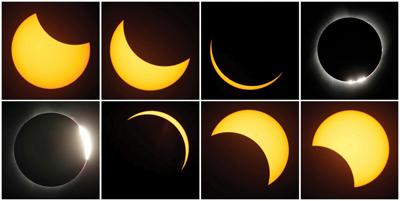Come for the cosmos, stay for the cocktails?
Folks in the tourism sector are hoping that the untold thousands of people descending on Vermont in just under eight weeks to witness a total eclipse of the sun won’t just pack up and head out once the show is over.
“We are hoping the mass exodus won’t happen,” Mary Monteith, marketing manager with the Stowe Area Association, said during a brief eclipse planning talk last Thursday.
A total solar eclipse occurs when the moon passes between the sun and Earth, completely blocking the face of the bright yellow orb. It’s a rare occurrence, and northern Vermont happens to be right in the middle of the path of totality. The next time it happens will be the year 2106.
The path takes a northeasterly route through the United States from Texas to Maine and is projected to be just over 100 miles wide when it gets to Vermont — roughly stretching between Montpelier and Montreal. In Lamoille County, the sun will blocked out for nearly three minutes.
Wyoming, with a population even smaller than Vermont’s, offers a taste of what Vermont might expect for visitors. In 2017, the state’s population essentially doubled for a similar ultra-hyped total eclipse. According to the Denver Post, more than 536,000 vehicles flocked to Wyoming’s roads, rivaling the total number of registered vehicles in the entire state. The state’s office of tourism claimed it was the “biggest one day event in Wyoming’s history.”
The state had prepared for the influx, but state officials were still surprised to see that, although people driving into the state may have arrived somewhat gradually, they left practically all at once.
Sara De Felippi, with the Vermont Department of Tourism and Marketing, said to avoid what happened in Wyoming, with “backups for miles and miles and miles,” the state will set up a smartphone-based alert system that out-of-towners can join when they cross into the state to track traffic levels.
Monteith and others at Stowe Area Association hope to convince many of the incoming tourists to stick around. She said a big difference between that event and the April 8 eclipse is timing — the Wyoming eclipse was over by late morning and people headed out, whereas occupancy data shows people are booking rooms for Monday night, too, suggesting a huge influx of people sticking around after the eclipse.
Monteith urged restaurants and bars that might otherwise be closed on Sundays and Mondays — or mud season, period — to open their doors and prepare for a ton of business.
Jen Greene, marketing manager with the association, said the influx of people into the area during an otherwise sleepy tourist season provides an opportunity to sell visitors on future visits, when there are more things to do, places to explore and events to attend.
“We have an opportunity to really tell our story and have that experience,” she said.
Monteith said lodging occupancy data for Sunday night suggests something “pretty close to peak foliage levels,” even though early April is typically associated more with mud season specials and opportunities for hotel and inn owners to get started on cleaning and renovation projects or take their own vacations. She said, as of last week, only three properties had vacancies for the eclipse weekend, and those will likely fill up, with many last-minute reservations.
The association will, in the next two months, begin showcasing on its website things like eclipse watch parties at area watering holes or information like road closures.
Providing visitors with something to do will be key, especially with the very real possibility the day of the eclipse turns out the be cloudy, rainy or both — it is April in Vermont, after all, a typically overcast month.
Carrie Simmons, Stowe Area’s executive director, said Vermont has a lot of “micro-climates,” which could make things dicey as eclipse hunters with their eyes on their weather apps start chasing any clear-skied spots that might be found scattered around the Green Mountain State.
Stowe police chief Don Hull said the town is working on identifying designated parking areas, such as the high school and elementary school parking lots, and recreation path parking areas. He said where drivers park will be weather dependent — if it’s a nice day, he anticipates many people will park at the popular Pinnacle trailhead and hike up to watch the event. The police department will monitor and limit traffic, especially along the upper part of Mountain Road, to make sure drivers don’t simply pull off the side of the road to watch the eclipse. He said the town has not planned any road closures yet but said there are some areas of concern during the early mud season — the backside of Trapp Hill Road, for instance.
Greene said the organization will emphasize to visitors the importance of protecting and maintain “softer areas” that will be extra delicate during mud season and get people to stick to harder surfaces.
“We know that, obviously, not everyone will follow that, but we’re really encouraging certain areas that are either paved parking lots or harder surfaces in general,” Greene said.
















(0) comments
Welcome to the discussion.
Log In
Keep it clean. Please avoid obscene, vulgar, lewd, racist or sexual language.
PLEASE TURN OFF YOUR CAPS LOCK.
Don't threaten. Threats of harming another person will not be tolerated.
Be truthful. Don't knowingly lie about anyone or anything.
Be nice. No racism, sexism or any sort of -ism that is degrading to another person.
Be proactive. Use the "Report" link on each comment to let us know of abusive posts.
Share with us. We'd love to hear eyewitness accounts, the history behind an article.